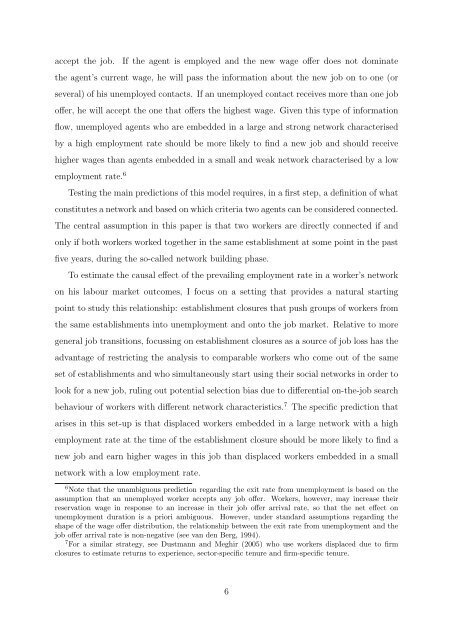paper - Universitat Pompeu Fabra
paper - Universitat Pompeu Fabra
paper - Universitat Pompeu Fabra
Create successful ePaper yourself
Turn your PDF publications into a flip-book with our unique Google optimized e-Paper software.
accept the job.<br />
If the agent is employed and the new wage offer does not dominate<br />
the agent’s current wage, he will pass the information about the new job on to one (or<br />
several) of his unemployed contacts. If an unemployed contact receives more than one job<br />
offer, he will accept the one that offers the highest wage. Given this type of information<br />
flow, unemployed agents who are embedded in a large and strong network characterised<br />
by a high employment rate should be more likely to find a new job and should receive<br />
higher wages than agents embedded in a small and weak network characterised by a low<br />
employment rate. 6<br />
Testing the main predictions of this model requires, in a first step, a definition of what<br />
constitutes a network and based on which criteria two agents can be considered connected.<br />
The central assumption in this <strong>paper</strong> is that two workers are directly connected if and<br />
only if both workers worked together in the same establishment at some point in the past<br />
five years, during the so-called network building phase.<br />
To estimate the causal effect of the prevailing employment rate in a worker’s network<br />
on his labour market outcomes, I focus on a setting that provides a natural starting<br />
point to study this relationship: establishment closures that push groups of workers from<br />
the same establishments into unemployment and onto the job market. Relative to more<br />
general job transitions, focussing on establishment closures as a source of job loss has the<br />
advantage of restricting the analysis to comparable workers who come out of the same<br />
set of establishments and who simultaneously start using their social networks in order to<br />
look for a new job, ruling out potential selection bias due to differential on-the-job search<br />
behaviour of workers with different network characteristics. 7 The specific prediction that<br />
arises in this set-up is that displaced workers embedded in a large network with a high<br />
employment rate at the time of the establishment closure should be more likely to find a<br />
new job and earn higher wages in this job than displaced workers embedded in a small<br />
network with a low employment rate.<br />
6 Note that the unambiguous prediction regarding the exit rate from unemployment is based on the<br />
assumption that an unemployed worker accepts any job offer. Workers, however, may increase their<br />
reservation wage in response to an increase in their job offer arrival rate, so that the net effect on<br />
unemployment duration is a priori ambiguous. However, under standard assumptions regarding the<br />
shape of the wage offer distribution, the relationship between the exit rate from unemployment and the<br />
job offer arrival rate is non-negative (see van den Berg, 1994).<br />
7 For a similar strategy, see Dustmann and Meghir (2005) who use workers displaced due to firm<br />
closures to estimate returns to experience, sector-specific tenure and firm-specific tenure.<br />
6
















